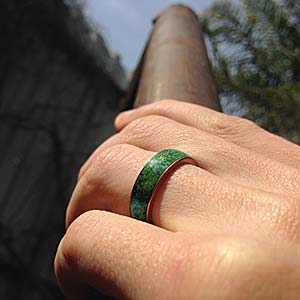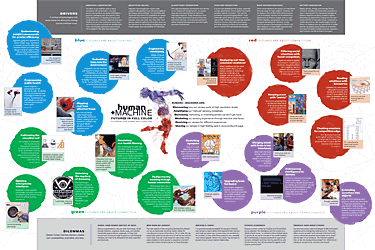Future Now
The IFTF Blog
The Green Connection: A Human+Machine Futures Scenario
You shake hands with an old friend and sit down for lunch in the cafe. It is so good to see them. After having a moment the look of joy on their face turns to one of concern. Your friend looks apologetically down at their hand which is still shaking yours and they confess, “So sorry, I’m just getting over a cold. It shouldn’t be contagious. The doctor said—”
 You interrupt them, unworried about the cold, “Don’t worry, it will be fine. It is good to see you. How are the kids?”
You interrupt them, unworried about the cold, “Don’t worry, it will be fine. It is good to see you. How are the kids?”
Ten years ago you would have rushed off to the restroom and washed with antibacterial soap. But times have changed. Instead of sterilizing your hand, you rub it over the emerald green ring on your finger, making sure that any viruses or bacteria have a chance to penetrate the porous surface. If your body was at risk of becoming ill, then the green organism living in the ring would take on an amber hue. In that case it would be a good idea to rinse with a probiotic immune boosting agent. However after a few seconds, the ring remains a vibrant emerald green, signaling a healthy immune system with no risk of contamination.
Interacting with this ring has become second nature for you. The puzzled look on your friends face hints that they have never seen such a ring, so you explain the basics.
They nod and say “So your ring is alive. Like a plant. Or an animal.”
“Yes it is alive” you say. “It's not some other organism though. This ring is a part of me. It is a little window where I can see how my immune system and microbiome are doing.”
“Does it work?” they ask.
“It took some getting used to. After getting one cold and another fever, I learned how to read the mood of the ring a little better and haven’t been sick since. I couldn’t imagine living without it.”
Signals of this green future from today
While the technologies we see in the scenario do not necessarily exist today, you can find signals from today that suggest this scenario as a possible future in the coming decade.
It is said that some people wear their heart on their sleeve. Jens Dyvik, a student at the Design Academy of Eindhoven, took this idiom quite literally. Ref is a device that helps you become aware of your emotional state by monitoring your heart rate and reflecting that data through a friendly kinetic wrist sculpture. Showing previously invisible patterns from within the body will help us become more connected to our varying physical and mental states.
- Growing your brain in a petri dish is a real possibility today, in 2015. Researchers have successfully grown small portions of patient’s cerebral cortex in the lab for testing the effects of drugs prescribed for psychological conditions. Every human’s brain is different, so it is impossible to know for sure how the patient will react—or at least it used to be impossible. By creating a window into something that was previously unknown we can gain a better understanding of ourselves and each other, allowing for more meaningful connections, which is very much a green future.
- With the advent of genetic testing, we discovered that the human body isn’t entirely human. In fact, we’re mostly not human. For every ten cells in the body, nine of them are microorganisms. These microbes love on our skin, in our eyes, they help digest food, tweak the immune system, and affect psychology. A red scenario might attempt to dominate the human body, while a blue scenario may attempt to control it. In this green scenario, however, we see the human body as diverse thriving and deeply interconnected ecosystem.
A scenario about interconnectedness in human+machine futures
 This scenario is one of the four possibilities we imagined in our new map, Human+Machine Futures in Full Color: Extending Our Senses and Ourselves, the first in our 2015 Technology Horizons program’s series of projects about Human+Machine Futures—the blurring lines between human and machine, natural and artificial. The map forecasts how emerging technology is creating what are today vast and unknown territories of human sensory experience. Rooted in the color-based systems mythology tool IFTF developed in 2014, we intended for the map’s forecasts, scenarios, and artifacts from the future to help us imagine how the future of human-machine symbiosis will be colored by our priorities, concerns, and values.
This scenario is one of the four possibilities we imagined in our new map, Human+Machine Futures in Full Color: Extending Our Senses and Ourselves, the first in our 2015 Technology Horizons program’s series of projects about Human+Machine Futures—the blurring lines between human and machine, natural and artificial. The map forecasts how emerging technology is creating what are today vast and unknown territories of human sensory experience. Rooted in the color-based systems mythology tool IFTF developed in 2014, we intended for the map’s forecasts, scenarios, and artifacts from the future to help us imagine how the future of human-machine symbiosis will be colored by our priorities, concerns, and values.
What is the color of the future you want to design?
These signals may sound like they are from a far-out science fiction story, but they are here today. When are combined into a singly Artifact from the Future, the effect is magical. It is a technology that sounds impossible, but it is entirely plausible. In a green world, one that prioritizes interconnectedness and freedom, these signals are friendly. But how might the same signals manifest in a red world where people are fighting to win, or a blue world where every aspect of existence is tightly controlled? These are the kinds of questions we designed these scenarios to provoke. Over the next several weeks, we’ll post the other three scenarios and artifacts, painting a picture of the full color spectrum of emerging technologies shaping the human-machine relationship, in the hopes that it helps you design for the future in which you’d like to live.
This post is from one of Technology Horizons 2015 forecast maps, Humans+Machine Futures in Full Color: Extending Our Senses and Ourselves, which explores how advances in technology will create new forms of human-machine symbiosis, expanding and even redefining what we can do with our five senses.
Also see:
- The Red Competition: A Human+Machine Futures Scenario
- The Blue City: A Human+Machine Futures Scenario
- The Purple Transformation: A Human+Machine Futures Scenario
Curious about Technology Horizons?
- Follow us @iftf
- Find out more about the Technology Horizons program
- Check out previous years' Technology Horizons research
- Contact Sean Ness at sness@iftf.org




